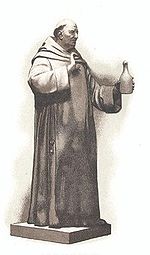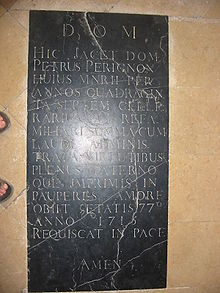- Dom Pérignon (person)
-
 Statue of Dom Pérignon at Moët et Chandon
Statue of Dom Pérignon at Moët et Chandon
Dom Pierre Pérignon, O.S.B., (c. 1638–14 September 1715) was a French Benedictine monk who made important contributions to the production and quality of Champagne wine in an era when the region's wines were predominantly still and red. Popular myths frequently, but erroneously, credit him with the invention of sparkling Champagne, which didn't become the dominant style of Champagne until mid-19th century.
The famous champagne Dom Pérignon, the préstige cuvée of Moët & Chandon, is named after him.
Contents
Biography
Pierre Pérignon was born to a clerk of a local judge in the town of Saint-Menehould in the Champagne region of northern France. When he was 19 he entered the Benedictine Order, first doing his novitiate at the Abbey of Saint-Vannes near the town of Verdun. In 1668, he transferred to the Abbey of Hautvillers near the town of Épernay. He served as Cellarer of the Abbey until his death in 1715.[1] Under his stewardship, the Abbey flourished and doubled the size of its vineyard holding. As a sign of honor and respect, Dom Pierre was buried in a section of the Abbey cemetary traditionally reserved only for abbots.[2]
Influence of Champagne production
Dom Pérignon is buried in the church of Hautvillers, région Champagne
In his era the in-bottle refermentation that gives sparkling wine its sparkle was an enormous problem for winemakers. When the weather cooled off in the autumn, refermentation would sometimes keep fermentable sugars from being converted to alcohol. If the wine was bottled in this state, it became a literal time bomb. When the weather warmed in the spring, dormant yeast roused themselves and began generating carbon dioxide that would at best push the cork out of the bottle, and at worst explode, starting a chain reaction. Nearby bottles, also under pressure, would break from the shock of the first breakage, and so on, which was a hazard to employees and to that year's production. Dom Pérignon thus tried to avoid refermentation.
In 1718, Canon Godinot published a set of wine making rules that were said to be established by Dom Pérignon. Among these rules was the detail that fine wine should only be made from Pinot Noir. Pérignon was not fond of white grapes because of their tendency to enter refermentation. Other rules that Godinot included was Pérignon's guidance to aggressively prune vines so that they grow no higher than three feet and produce a smaller crop. Harvest should be done in cool, damp conditions (such as early morning) with every precaution being taken to ensure that the grapes don't bruise or break. Rotten and overly large grapes were to be thrown out. Pérignon did not allow grapes to be trodden and favored the use of multiple presses to help minimize macerations of the juice and the skins.[3]
Dom Pérignon was also an early advocate of winemaking using only natural process without the addition of foreign substances.[4] Today we might call this "organic" winemaking to distinguish it from other commonly used winemaking methods, though the word "organic" connotes modern cultural and political views, in addition to techniques for sustainable agriculture, that Dom Pérignon most likely did not hold.
Misconceptions and myths
The quote attributed to him—"Come quickly, I am drinking the stars!"—is supposedly what he said when tasting the first sparkling champagne. However, the first appearance of that quote appears to have been in a print advertisement in the late 19th century.[5]
While the Dom did work tirelessly and successfully to improve the quality and renown of the still wines of Champagne, he did not invent sparkling wine, nor was he the first to make champagne. Indeed he worked hard to prevent a secondary fermentation which was seen as a fault and most likely to break the wine bottles.[5] There is documentary evidence that sparkling wine was first intentionally produced by English scientist and physician Christopher Merret.[6]
A major proponent of the misconceptions surrounding Dom Pérignon came from one of his successors at the Abbey of Hautvillers, Dom Groussard, who in 1821 gave an account of Dom Pérignon "inventing" Champagne among other exaggerated tales about the Abbey in order to garner historical importance and prestige for the church.[1] The myths about Pérignon being the first to use corks and being able to name the precise vineyard by tasting a single grape likely originated from Groussard's account.[7]
Prior to blending he would taste the grapes without knowing the source vineyard to avoid influencing his perceptions. References to his "blind tasting of wine" have led to the common misconception that Dom Pérignon was blind.
Contrary to popular belief, Dom Pérignon did not introduce blending to Champagne wines but rather the innovation of blending the grapes prior to sending them to press.[8]
See also
- History of Champagne
- List of wine personalities
References
- ^ a b R. Phillips A Short History of Wine pg 245 Harper Collins 2000 ISBN 0066212820
- ^ D. & P. Kladstrup Champagne pg 38 Harper Collins Publisher ISBN 0060737921
- ^ H. Johnson Vintage: The Story of Wine pg 213-214 Simon and Schuster 1989 ISBN 0671687026
- ^ D. & P. Kladstrup Champagne pg 26 Harper Collins Publisher ISBN 0060737921
- ^ a b R. Phillips A Short History of Wine pg 138 Harper Collins 2000 ISBN 0066212820
- ^ Liger-Belair, Gérard (2004). Uncorked: The Science of Champagne. Princeton University Press, pg.12-13. ISBN 978-0-691-11919-9
- ^ H. Johnson Vintage: The Story of Wine pg 210 Simon and Schuster 1989 ISBN 0671687026
- ^ H. Johnson Vintage: The Story of Wine pg 214 Simon and Schuster 1989 ISBN 0671687026
Notes
- Stevenson, Tom. World encyclopedia of Champagne and Sparkling Wine. San Francisco, California: Wine Appreciation Guild (revised edition)..
Categories:- Vintners
- French winemakers
- Benedictines
- 1630s births
- 1715 deaths
- French monks
- French Christian monks
- Year of birth uncertain
Wikimedia Foundation. 2010.

